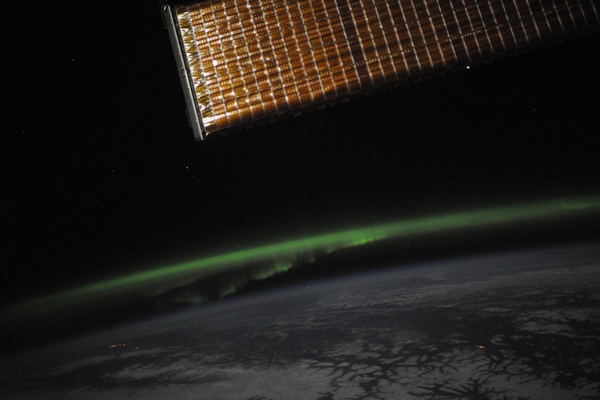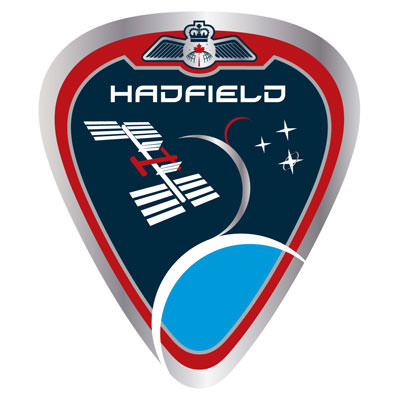Who knew it could take almost seven minutes to get a tour of the teeny-tiny crew quarters on board the International Space Station? But Expedition 26 Commander Scott Kelly provides an engaging peek inside his personal living space, and an inside look at life aboard the ISS.
Breathtaking Recent Aurora Images from Earth and Space
[/caption]
With the Sun’s activity increasing just a bit, sky watchers have witnessed an uptick in aurorae, especially northern observers. This top image is from an *extreme* northern observer, as in way up; about 320 km (220 miles) up above the Earth. Astronaut Doug Wheelock took this image from the International Space Station, and the beautiful sight made him wax poetic:
“Aurora Borealis as I will forever paint it in my dreams,” he wrote on Twitter. “Almost time to return home… no regrets… but mixed emotions. Leonardo da Vinci was right… ‘For once you have tasted flight, you will forever walk the Earth with your eyes turned skyward, for there you have been… and there you will long to return.'”
See other stunning recent aurora images from a more Earthly viewpoint:
These particular aurorae sightings were likely the result of a solar flare that erupted towards Earth on Nov. 12.
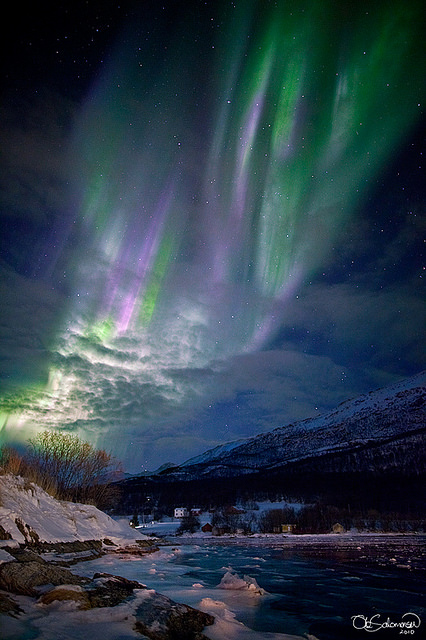
Describing this picture, Salomonsen said on Flickr: “With a CME expected to hit earth on Nov.14th we could still see only a faint aurora. We got frustrated and then decided to drive back towards the city where it now was reported to clear up. After 5 minutes in the car suddenly we could see a strong aurora bursting out behind the partially cloudy sky.”
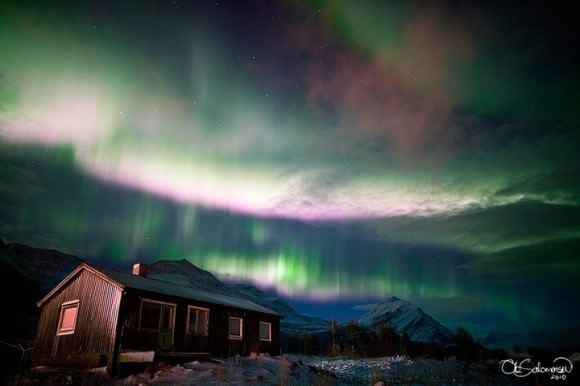
This is another gorgeous shot by Salomonsen, and on his Flickr site, he points out Ursa Major is visible in the top left, said it was just amazing how there were two rays of white and purple aurora, one moving faster than the other.
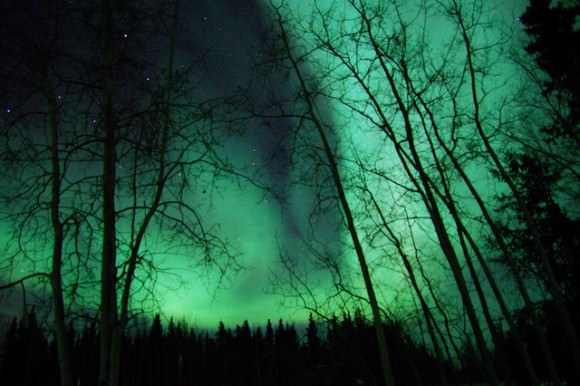
Photographer Sean Davies took this image on Nov. 13, 2010 near Dettah in the Northwest Territories, Canada, and said, “The aurora put on a great show just outside Yellowknife. The show lasted a good hour.” There’s another from Sean, below, on the same night. You can see more of Sean’s images at his Flickr site.
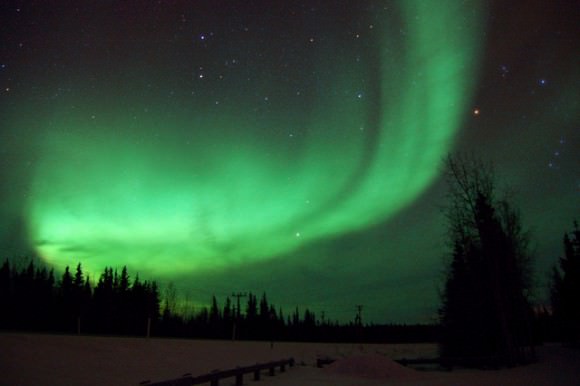
The photo below was taken on November 13, 2010 in Auster-Skaftafellssysla, Iceland by Skarphéðinn Þráinsson. See more of his images at Flickr.
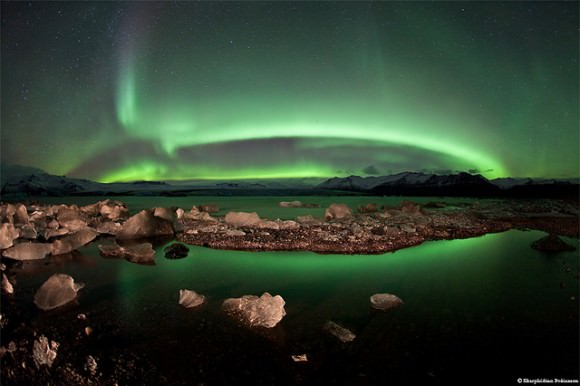
This timelapse video was taken by Tor Even Mathisen, also from Tromsø, Norway.
Aurora Borealis timelapse HD – Tromsø 2010 from Tor Even Mathisen on Vimeo.
*Posted especially for Hon. Salacious B. Crumb
Stunning Image, Heartfelt Poetry Could Become Icons of Space Age

[/caption]
Undoubtedly, this picture has what it takes to become an iconic image of human spaceflight, much like Apollo 8’s Earthrise or Bruce McCandless’ untethered spacewalk. Here, astronaut Tracy Caldwell Dyson looks down at Earth from the Cupola on the International Space Station, likely reflecting on both her home and her home in space. Everyone I know who has seen this image has just melted, with a sigh that says, “Oh, wow — that is just amazing!” (It made today’s Astronomy Picture of the Day.) My initial thoughts were that this is the one of the most poetic image of human spaceflight I have ever seen. And sure enough, Stuart Atkinson (the guy who I nominate at the Poet Laureate of Space) was inspired by this image, too. He has written a magnificent, heartfelt poem that captures the spirit –as well as the technology — of this image, and very likely sums up Caldwell Dyson’s thoughts as she gazes out the Cupola windows.
Read “Blue” by Stuart Atkinson:
BLUE
Ignoring the tsunami of technology humming behind her,
The chaos of cameras, computers and calculators
Covering the walls, she shuts her eyes and smiles.
This isn’t what she imagined as a girl.
In all those classroom daydreams she always saw herself
Looking down – or up – at the world from high above – or below –
Beside a plate-sized portal, straining to glimpse
Some small portion of the planet spinning silently beyond
The scratched and fingerprint-smeared glass, unable to see
More than mere hints of the colours, shadows and shapes
Shown in all the books and magazines…
But this…
Earth is there… everywhere…
A ball of burning blue close enough to touch.
Painted on the heavens in all its Van Gogh glory
It fills the sky, overflows her sight,
A startling Stargate of colour in an ocean of emptiness.
Even with her eyes closed she still sees its azure glow,
Feels its sapphire shades blazing in the ink-black night.
In the work-day-over darkness, Earthlight
Washes her face like cool rain as painfully beautiful
Whirls and whorls of milk-white cloud swirl
O’er the world below and she knows, in her aching
Heart, that long after she has returned to Terra,
To walk barefoot on its dew-drenched grass and
Splash in its ocean’s surging surf a part of her
Will always be here, at this window, gazing down
Upon the Earth.
© Stuart Atkinson 2010
Thanks to Stu for allowing us to publish his poem, a Universe Today exclusive! To see more of his poetry and imagery, check out his websites, Cumbrian Sky, and Road to Endeavour.
Seeing the Space Station is Something to Smile About
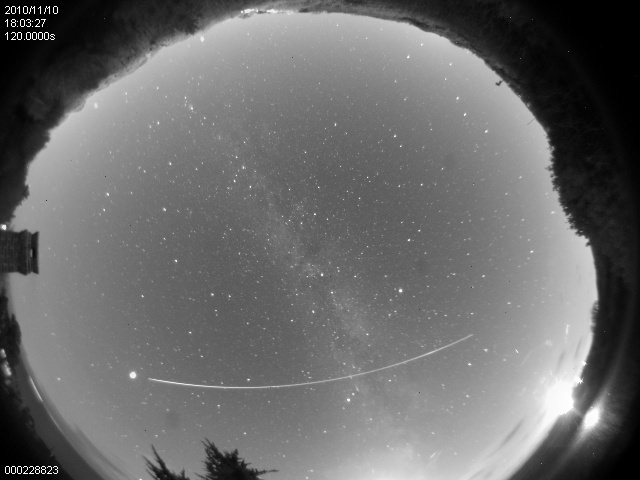
[/caption]
I know I always smile when I see the International Space Station in the night sky, but here the sky itself appears happy, with the ISS crossing the field of view of the Niton All-Sky camera. With a long exposure, a “star trail” forms as the space station moves across the sky. 🙂
The camera is located on the Isle of Wight and operated through the University of Hertfordshire. Check out the camera’s website — there a some great “unusual” images” which include meteors, atmospheric phenomena and even wildlife making an appearance.
Hat tip: Adrian West on Twitter.
Best of Earth from the ISS

The International Space Station has been orbiting the Earth every day for over 10 years, and the astronauts all say their favorite pastime is looking at the Earth. During the past 10 years, the crews have taken some great pictures of our planet, and these images provide a unique look at our world. These are just a few of the spectacular views of Earth from the space station.
Ten Years Of the ISS in Pictures
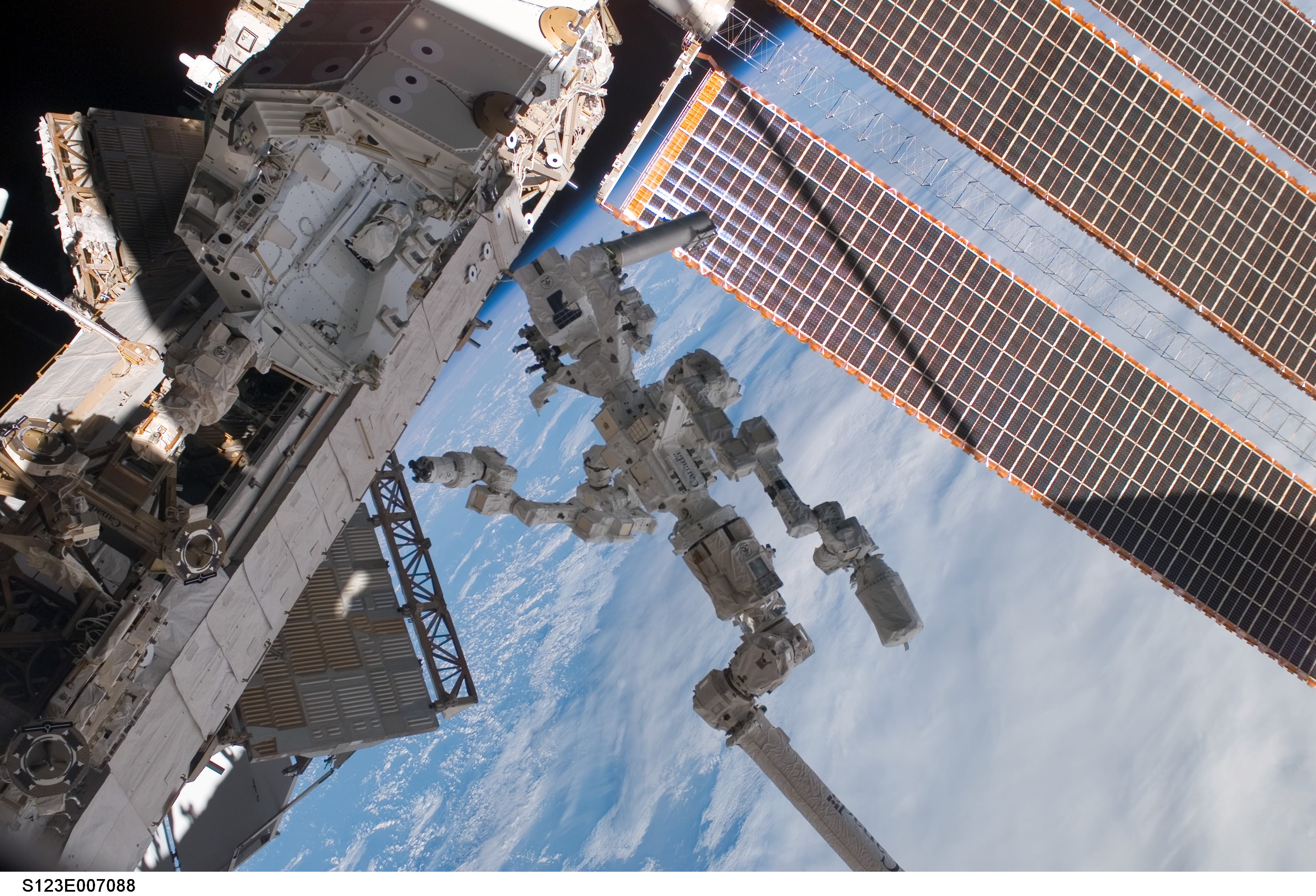
[/caption]
Ten years ago, the first Expedition crew arrived at the International Space Station. Here’s a look back in time at how the station has changed and grown, and some of the people who were there to make it happen.
And if you’re really feeling the love for the ISS today, check out our 2008 article, “I Heart the ISS; Ten Reasons to Love the International Space Station.”





















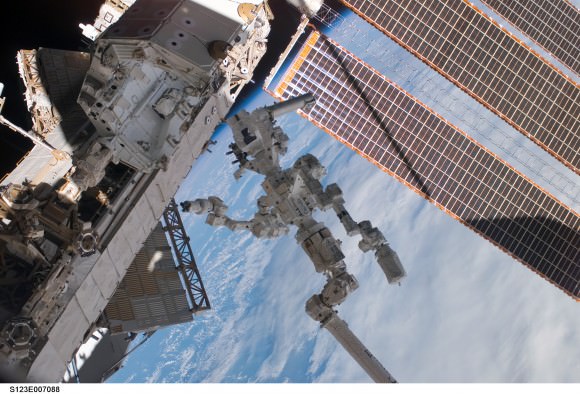







For a complete list of pictures of each of the ISS Expedition crews, see NASA’s gallery which shows all those who have served on the space station over the past 10 years.
10 Years of the ISS: First Commander Reflects on Anniversary
Ten years ago today US astronaut Bill Shepherd and Russian cosmonauts Sergei Krikalev and Yuri Gidzenko arrived at the fledgling International Space Station, after launching in a Soyuz rocket from the Baikonur Cosmodrome in Kazakhstan on October 31, 2000. This began a decade of continuous human habituation on board the station. The station’s first commander reflects on his mission and the past 10 years.
Oh Canada! Hadfield Named First Canadian Commander of ISS
Congratulations to one of our favorite astronauts, Chris Hadfield from Canada. Today NASA and the Canadian Space Agency announced Hadfield will be heading to the International Space Station in 2012, serving as Flight Engineer for Expedition 34, and then transitioning to Commander midway through his 6-month stay when Expedition 35 begins. Hadfield will be the first Canadian to serve as Commander for the ISS. His ebullient style and passion for space exploration — evident in the video above from today’s announcement (Hadfield speaks in both French and English, so don’t worry if you’re not fluent in one or the other) should make for a lively and enlightening time on the ISS.
“This honor is beyond words,” Hadfield said at today’s announcement. “To have this opportunity is extremely challenging, extremely exciting and extremely rewarding. It still is two years away, I still have to pass two more of the toughest physicals on Earth before they’ll let me get in that Soyuz and dock with the space station… To be trusted … with the entire station on behalf of all the world’s space faring nations, but specifically Canada is a tremendous honor that we all can share.”
While there have been several great ambassadors for the wonders of space exploration who have served on board the ISS, Hadfield is one astronaut who can truly share what the experience of spaceflight is really like. See our interview with Hadfield where he describes what it is like to go on a spacewalk. (Or you can listen to the interview on the 365 Days of Astronomy podcast here.) He also has a great description of how to go the bathroom in space.
[/caption]
Above is Hadfield’s mission patch, in the shape of a guitar pick, which is symbolic of Hadfield’s musical interests with an emphasis on science and art, a distinguishing feature of Expedition 34/35, says Robert Pearlman from collectSPACE.
Joining Hadfield will be US astronaut Tom Marshburn, and Russian cosmonaut Roman Romanenko will also serve as flight engineers for the Expedition 34 mission. Astronaut Kevin Ford and Russian cosmonauts Oleg Novitskiy and Evgeny Tarelkin were previously announced as the other crew members for Expedition 34, which begins when Soyuz 31 undocks from the station in October 2012.
Expedition 35 will begin with the undocking of Soyuz 32 in March 2013. At that time, Hadfield will serve as station commander, with Marshburn and Romanenko continuing as flight engineers. The three additional crew members for Expedition 35 have yet to be assigned.
Hadfield and Marshburn have already completed an expedition together on the NEEMO (NASA’s Extreme Environment Mission Operations) underwater habitat, so they should make a great team in space. You can read Universe Today’s interview with them during their mission under the sea.
Space Station Twitter Crew Returns Home
The Expedition 23 crew from the International Space Station landed safely in their Soyuz-17 spacecraft, concluding their five-and-a-half-month stay in space. Commander Oleg Kotov and Flight Engineers T.J. Creamer and Soichi Noguchi were welcomed by sunshine on Wednesday morning in Kazakhstan (11:25 pm EDT Tuesday). This crew may well be remembered as the ‘Twitter Crew’: Creamer posted the first “live” Tweet from space on Twitter from the now functioning internet on the ISS, which he helped to get up and running. Noguchi’s use of Twitter to post hundreds of images from space documented and shared his experiences in space like no previous astronaut, as he garnered over 250,000 Twitter “followers,” and his images were featured on many blogs and news sites.
Continue reading “Space Station Twitter Crew Returns Home”
Final Shuttle Flight Will Be Delayed at Least Until November for AMS Switchout
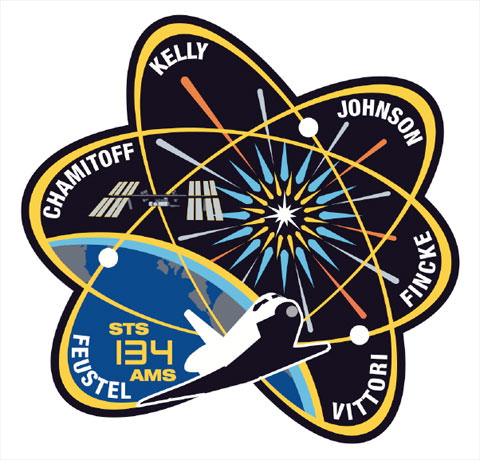
[/caption]
A switch-out of the magnet for a much anticipated particle physics experiment on the International Space Station will force NASA to delay the final flight of the space shuttle until at least November, and change which orbiter and crew will fly the final space shuttle mission. The $2 billion Alpha Magnetic Spectrometer was scheduled to head to the ISS in July of this year, but recent thermal vacuum tests showed the superconducting magnet that was originally planned to power the experiment would have only worked 2-3 years. An ordinary magnet, which doesn’t need to be super-cooled will last for a decade or more – and given the ISS has been given a longer life, it seems to be the best option. “I don’t think it’s correct to go there for three years where there is a chance to do physics for 18 years,” said Dr. Samuel Ting, AMS Principal Investor, in an article in the New York Times.
NASA officials said today they still are evaluating the exact day in November, as they must schedule the mission to fit around other resupply and crew flights to the ISS, with the Russian Progress and Soyuz vehicles.
The AMS is designed to search for various types of unusual matter by measuring cosmic rays, and will help researchers study the formation of the universe and search for evidence of dark matter and antimatter.
Changing the magnet means the AMS won’t arrive at Kennedy Space Center before August and shuttle workers need time to get the payload ready to fly inside the shuttle’s cargo bay.
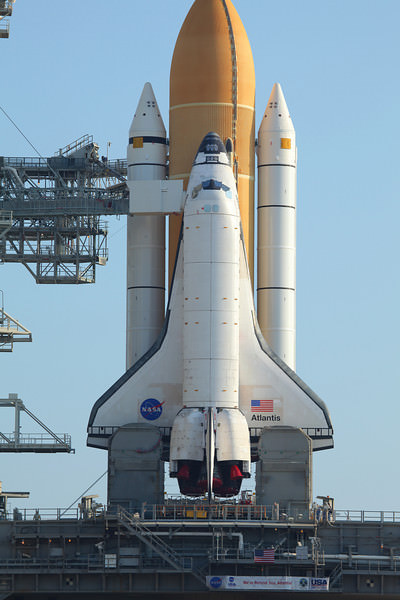
The upcoming flight of the shuttle Atlantis (STS-132) remains on schedule for launch no earlier than May 14. But Endeavour was scheduled for the AMS flight in July, which will now move to no earlier than November. Discovery’s STS-133 flight (bringing up the Leonardo MPLM as a permanent storage module) stays on the schedule for September 16. So while the schedule changes, numerical order is restored!
Another possible change to the shuttle schedule would be if the decision to fly what is called STS-335, the Launch On Need mission, a shuttle ready to go as a rescue ship for the last scheduled mission. Many shuttle supporters say since Atlantis would be ready to fly that it should fly. No decision has yet been made, however.
Even if the final flight or flights get delayed into 2011, funding is not a problem, as Congress anticipated possible delays and provided funds for shuttle operations into early next year.
Liquid helium would have been used cool the superconducting magnet’s temperature to near absolute zero. But tests showed the helium would dissipate withing 2-3 years, leaving the seven-ton experiment useless. The ISS has been extended to at least 2020, and possibly as long as 2028.
Sources: New York Times, Orlando Sentinel

